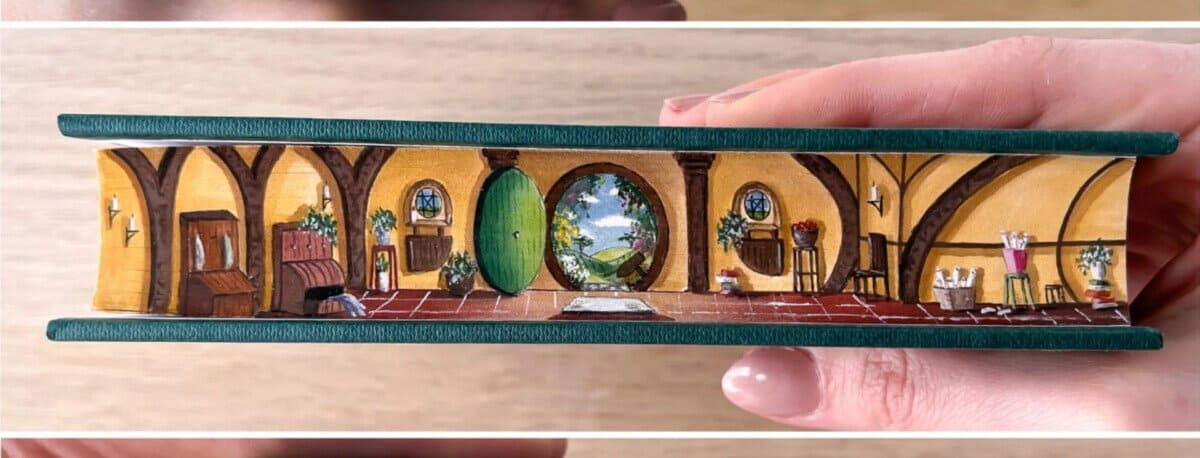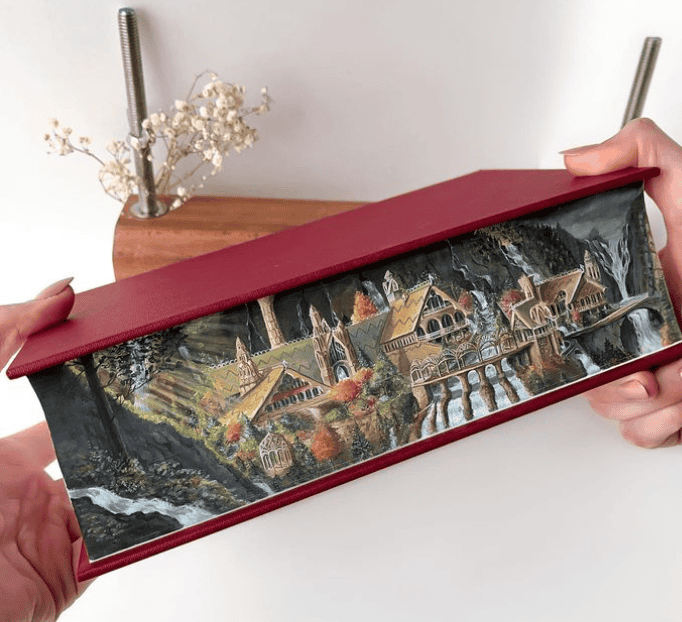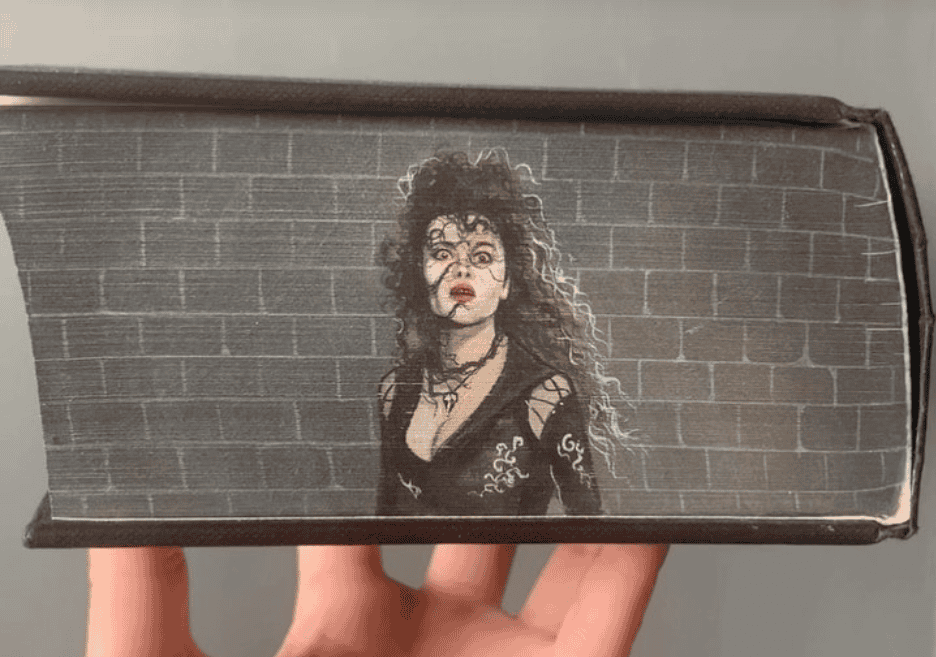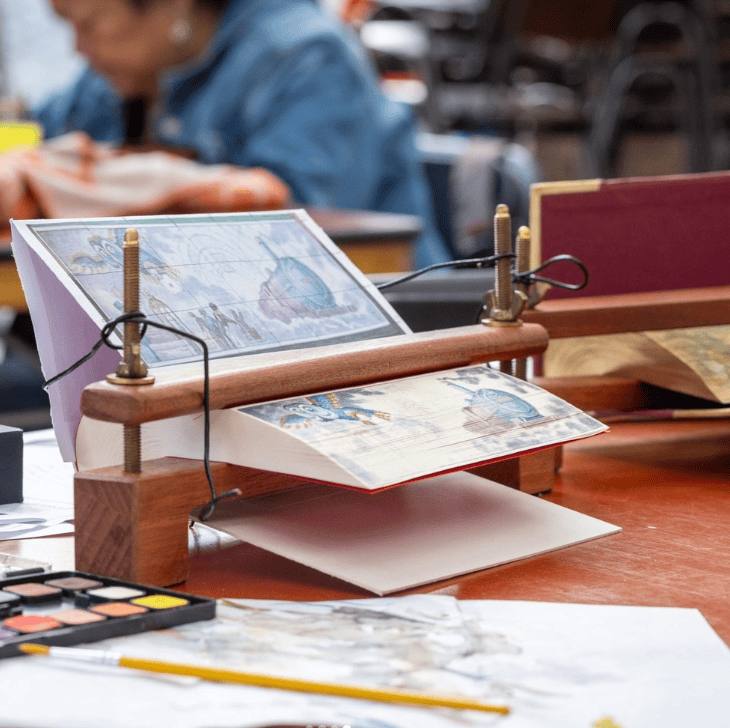Art Talk
What is Fore-Edge Painting?
History of Fore-Edge Painting
It’s a fascinating art form that has its roots in the 16th century. Imagine flipping through the pages of a book and discovering a hidden painting along the edge of the pages – that’s what fore-edge painting is all about.
In the early days, fore-edge paintings were created as a way to add extra decoration and beauty to books. Think of it as an artistic surprise for readers. Painters would typically use watercolours to create intricate scenes or landscapes on the exposed edge of the book.
Over time, artists began experimenting with different techniques such as double fore-edge paintings (where two different images can be seen from each direction) or split-fan paintings (where one image is revealed with one page fanning motion and another with an opposing fanning motion).
Historical Fore-Edge Painters
- Edwards of Halifax: Charles Forrest Edwards was a prominent fore-edge painter who worked during the late 18th and early 19th centuries. He became known for his intricate floral designs and landscapes painted on the edges of books. You can see a few incredible examples over at The Library of Trinity College of Dublin.
- Miss C.B. Currie: A female fore-edge painter active in the mid-19th century, Miss Currie gained recognition for her delicate miniature paintings featuring pastoral scenes, portraits, and literary motifs.
Styles and Themes in Fore-edge Paintings
- Rural Landscapes: Commonly feature pastoral scenes, farms, countryside views.
- Seascapes: Illustrations of oceans, ships, beaches, and coastal scenery.
- Famous Buildings: Images of historical landmarks, castles, churches, and cityscapes.
- Fantastical Architecture: Surreal or imaginative buildings, often with intricate details.
- Flowers: Various types of flowers, bouquets, and floral arrangements.
- Botanical Illustrations: Detailed depictions of plants, leaves, and natural elements.
- Famous Figures: Paintings of notable individuals, authors, historical figures.
- Personifications: Representations of allegorical or symbolic figures.
- Scenes from Literature: Depictions of scenes from famous works of literature.
- Character Portraits: Images of well-known literary characters.
- Biblical Scenes: Paintings of religious narratives, figures, and motifs.
- Mythological Depictions: Images from myths, legends, and folklore.
- Sexual themes: Painting depicting erotic acts intended as very private lovers gifts.
- Battle Scenes: Depictions of wars, conflicts, and historical battles.
- Court Events: Scenes from royal courts, ceremonies, and historical events.
- Wildlife: Paintings of animals, birds, insects, and other creatures.
- Mythical Beasts: Imaginary or legendary animals from folklore and mythology.
Different Styles of Fore-Edge Painting
Single Fore-Edge Painting
Single fore-edge painting represents the fundamental and classic form of this art. In this style, the artist paints a single image on the gilded edge of the book’s pages. The painting is only visible when the book is held in a specific way and the pages are fanned out. This style was prevalent during the 18th and 19th centuries, with artists commonly portraying landscapes, cityscapes, or other scenic views.
I am in love with the designs of Alice Diógenes, who creates some of the most colourful and detailed single fore-edge work I have come across. I must admit, I am rather fond of her washi tape. You can find out more over at the Alice in Walesland website
You should also to check out the legend that is Maise Matilda, the young Brit who went viral on Instagram for her astonishing single fore-edge painting. I must admit that I fall headlong into her work in progress reels on a regular basis, getting lost in the details. Check out the Maise Matilda Art Instagram page her, of buzz on over to youtube for an interview with Maise Matilda herself.
The Vanishing Art of the Disappearing Artwork!
The vanishing fore edge painting presents a mesmerizing and mysterious style within this art form. In this technique, the artist paints an image on the gilded edge of a book’s pages. However, the painting remains invisible until the book is held in a specific manner and the pages are fanned out. Upon closing the book, the painting vanishes without a trace.
This style gained popularity during the late 18th and early 19th centuries, with artists frequently portraying scenes relevant to the book’s content or theme. The disappearing effect was achieved through meticulous layers of paint and varnish, seamlessly blending with the gilded edges when the book was closed.
Our National Treasure
Martin Frost MBE is a renowned fore-edge painter hailing from the United Kingdom, known for his exceptional talent and creativity in this unique art form. With a passion for books and a keen eye for detail, Frost has captivated audiences with his exquisite hidden fore edge paintings that blend tradition with innovation.
Frost’s journey into fore-edge painting began with a deep appreciation for the beauty and craftsmanship of antique books. Inspired by the rich history and intricate designs found in centuries-old tomes, he embarked on a quest to revive and reinterpret this traditional art form for contemporary audiences.
Drawing on his background in fine arts and bookbinding, Frost honed his skills in hidden fore-edge painting, experimenting with different styles and techniques to create stunning and immersive artworks on the edge of a book. His dedication to precision and quality is evident in each of his pieces, which often feature intricate landscapes, vibrant scenes, and hidden surprises that delight viewers.
One of Martin’s signature techniques is the use of vibrant colours and meticulous detailing to bring his paintings to life. Whether he is depicting a serene countryside or a bustling cityscape, his work exudes a sense of depth and realism that draws the viewer into the miniature world hidden within the book’s pages.
As a master of his craft, Martin Frost continues to enchant and inspire audiences with his captivating fore-edge paintings, breathing new life into an age-old tradition and ensuring that this exquisite art form remains relevant and cherished for generations to come.
Martin holds workshops and talks throughout the UK and Europe occasionally. For an endangered artform I am always astonished by how quickly these book up, so you have better be quick! You can find out more information about his work and course dates over at the Martin Frost website. Be sure not to miss the gallery, for a truly jaw dropping dive into his artwork, and check out the Martin Frost Instagram page, full of videos and magic! . . . . .
If you want to see the one that made me swear and drop me tea CLICK HERE
Multi-Faceted Book Painting
The multifaceted fore-edge painting takes the art form to new heights, with the artist creating multiple paintings on the same book’s edges. In this style, the book’s pages are fanned out in different ways, revealing a series of distinct images, each one more captivating than the last.
This intricate and complex style of fore-edge painting became popular in the late 19th and early 20th centuries, with artists pushing the boundaries of what was possible with this unique art form. The multifaceted technique often involved the use of multiple layers of paint, as well as intricate masking and blending techniques, to create a seamless and visually stunning series of images. You will find examples of the Multifaceted Fore edge technique by Martin Frost on his Instagram page – HERE
Appreciating the Artistry of Fore-edge Painting
As our post comes to an end, I hope you are filled with appreciation for the beauty of fore-edge painting and eager to learn more about this endangered tradition.
Whether you’re a seasoned collector or simply someone who appreciates the magic of books and art, delving into the world of fore-edge painting will not fail to enchant you, the further down the rabbit hole you go. So, the next time you come across an antique or rare book, take a moment to fan its pages as you never know what you may discover inside.








I had never heard of fore edge painting until I came across this blog. Absolutely fascinating!
Wow! I’d never heard of this before! Utterly stunning. The painting Martin Frost did on the Bible is exquisite! I can get lost down this rabbit hole too!
Now off to scroll Instagram to see this art! As a book lover this is something that sparks my interest
Wow! Utterly stunning. The painting Martin Frost did on the Bible is exquisite! I can get lost down this rabbit hole too!
I am captivated by this intricate art form that involves creating beautiful works of art on the edges of book pages.I am captivated by this intricate art form that involves creating beautiful works of art on the edges of book pages. Just blows my mind.